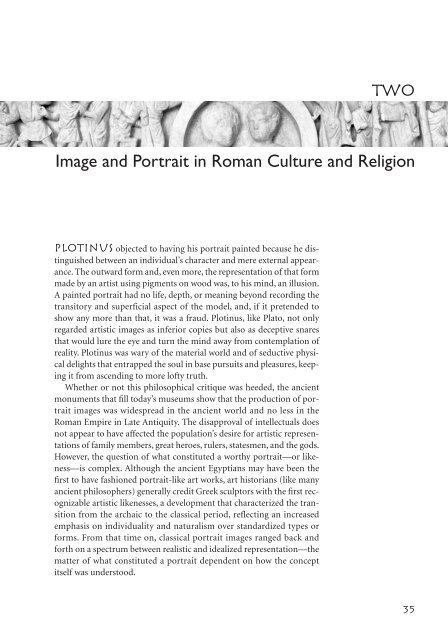You also want an ePaper? Increase the reach of your titles
YUMPU automatically turns print PDFs into web optimized ePapers that Google loves.
Plotinus objected <strong>to</strong> having his portrait painted because he distinguished<br />
between an individual’s character and mere external appearance.<br />
The outward form and, even more, the representation of that form<br />
made by an artist using pigments on wood was, <strong>to</strong> his mind, an illusion.<br />
A painted portrait had no life, depth, or meaning beyond recording the<br />
transi<strong>to</strong>ry and superficial aspect of the model, and, if it pretended <strong>to</strong><br />
show any more than that, it was a fraud. Plotinus, like Pla<strong>to</strong>, not only<br />
regarded artistic images as inferior copies but also as deceptive snares<br />
that would lure the eye and turn the mind away from contemplation of<br />
reality. Plotinus was wary of the material world and of seductive physical<br />
delights that entrapped the soul in base pursuits and pleasures, keeping<br />
it from ascending <strong>to</strong> more lofty truth.<br />
Whether or not this philosophical critique was heeded, the ancient<br />
monuments that fill <strong>to</strong>day’s museums show that the production of portrait<br />
images was widespread in the ancient world and no less in the<br />
Roman Empire in Late Antiquity. The disapproval of intellectuals does<br />
not appear <strong>to</strong> have affected the population’s desire for artistic representations<br />
of family members, great heroes, rulers, statesmen, and the gods.<br />
However, the question of what constituted a worthy portrait—or likeness—is<br />
complex. Although the ancient Egyptians may have been the<br />
first <strong>to</strong> have fashioned portrait-like art works, art his<strong>to</strong>rians (like many<br />
ancient philosophers) generally credit Greek sculp<strong>to</strong>rs with the first recognizable<br />
artistic likenesses, a development that characterized the transition<br />
from the archaic <strong>to</strong> the classical period, reflecting an increased<br />
emphasis on individuality and naturalism over standardized types or<br />
forms. From that time on, classical portrait images ranged back and<br />
forth on a spectrum between realistic and idealized representation—the<br />
matter of what constituted a portrait dependent on how the concept<br />
itself was unders<strong>to</strong>od.<br />
TWO<br />
Image and Portrait in Roman Culture and Religion<br />
35


